How to setup Joomla on fedora
First of all we need to make sure that php and mysql is install on our system included our webserver
[ismail@localhost ~]$ which php mysql httpd
/usr/local/bin/php
/usr/bin/mysql
/usr/sbin/httpd
If php or mysql or apache server is not installed you can install with following commands
[ismail@localhost ~]$ sudo yum -y install httpd php mysql mysql-server php-mysql
Alright now php mysql and apache(httpd) server is installed now we need to download Joomla from its site
[ismail@localhost ~]$ wget http://joomlacode.org/gf/download/frsrelease/10785/42655/Joomla_1.5.14-Stable-Full_Package.zipNow Next steps are to be performed by root user
[ismail@localhost ~]$ su
Password:
[root@localhost ismail]#
Now Create a directory of your project in my case i have choosed mysite it can be any thing
[root@localhost ismail]# mkdir /var/www/html/mysite Now we are going to move downloaded file of joomla in our site diectroy where we will extract files from zip
[root@localhost ismail]# mv Joomla_1.5.14-Stable-Full_Package.zip /var/www/html/mysite/ [root@localhost ismail]# cd /var/www/html/mysite [root@localhost mysite]# unzip Joomla_1.5.14-Stable-Full_Package.zip [root@localhost mysite]# rm Joomla_1.5.14-Stable-Full_Package.zipNow we need to create a configuration file and make it read and write able
[root@localhost mysite]# vi configuration.php [root@localhost mysite]# chmod 666 configuration.php [root@localhost mysite]# firefox localhost/mysite & Now configuring joomla
open your browser and type following on url
localhost/mysite 
Click next after selecting your language default is english
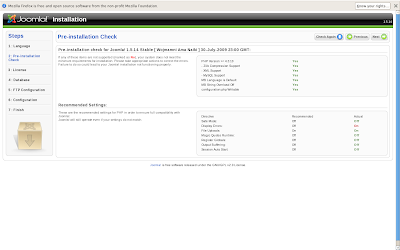
Click next again its telling you your stats about your configuration
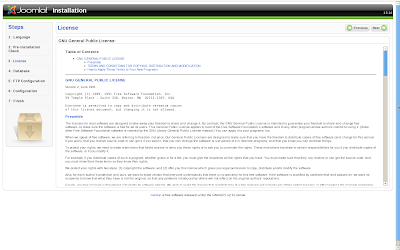
Click next to accept the agreement statement
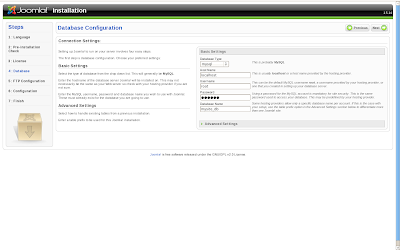
Now first select database (Mysql) than tell your host name most probably your will be also localhost Next select username of mysql server i choosed root and than entered the password of your database server of root and last box is of database name i have choosed mysite_db as my database for my project of joomla. Now click next
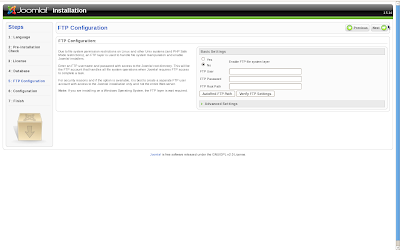
Now select yes if you want ftp support on i choosed it as off and click next
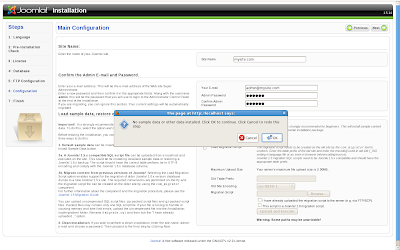
Now enter your site configuratins such as site Name your Email address and your password for administrator Admin password now don't bother next steps i recommend to click next afer filling site name , email , password and confirm password and now click next pop up will come click ok to continue
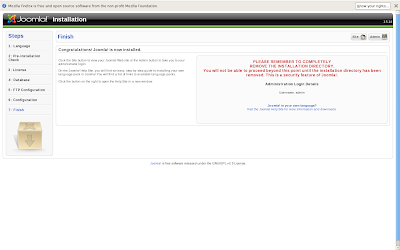
Alright now you have done with configuration now you jsut need to delete a folder from installation folder folder name installation in mysite folder delete that
Folder you have to delete will be in following location /var/www/html/mysite/installation [ismail@localhost ~]$ sudo rm -r /var/www/html/mysite/installation/
After you have deleted installation folder just type this url on your browser
localhost/mysite 
Now you see is your home page and now to get start working type following url on browser
localhost/mysite/administrator 
Enter user name as admin and password what you choosed during installation
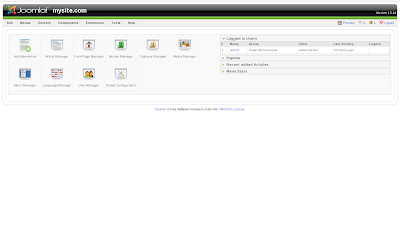
Here you are done with installation and configuration of Joomla and now you can create manage your joomla site





hi thanks for your time i do what you say but i cant install pulgin i have this messages
ReplyDelete* Warning! Failed to move file.
i cant install pulgin or theme to, i have this messages
ReplyDelete* Warning! Failed to move file.
how i use ftp in fedora 13
tnks my friend
thank you ismail awesome bir anlatım olmuş
ReplyDeletethank you for this nice post
ReplyDeleteits really helpful
i have done all the things till the last option which joomla tell remove the installation files
which file should i delete i need this rest of all i have done the thing
n once again thank you
happy new year
Thanks a Lot Friend
ReplyDeleteFedora 13:
ReplyDeletelocalhost/mysite would display directory not joomla installation
Windows XP:
after selecting English as Language, clicking "next" would not bring me to pre-installation check
Help.
i got a problem , at second step
ReplyDeleteconfiguration.php Writeable is no ,wht shld i do ? cn anyone hlp me :) tq
hi i tried what u said..when i reached in typing localhost/mysite in address bar, page cannot be found message come..what shall i do pls help
ReplyDeleteI have done all the steps except mention below. help me to get through it.
ReplyDeleteNow we need to create a configuration file and make it read and write able
[root@localhost mysite]# vi configuration.php
[root@localhost mysite]# chmod 666 configuration.php
[root@localhost mysite]# firefox localhost/mysite &
Nice site! I enjoy a couple of from the articles which have been written, and particularly the comments posted! I will definately be visiting again!
ReplyDeleteHire website developers
I just installed Joomla 1.7 on Fedora 14 using these directions. It went well on the first try. The only change I made was using rm -rf instead of rm -f to remove the installation directory. The rm -r prompts for a confirmation for every file.
ReplyDeleteGood post, thank you.
Now i think, It went well on the first try. The only change I made was using rm -rf instead of rm -f to remove the installation directory. The rm -r prompts for a confirmation for every file.
ReplyDeleteNice Article , it helped me allot, thanks for this article
ReplyDeleteشكرا اسماعيل على الطرح الرائع والمفيد ولكن هناك مشكلة بسيطة عند ما دخلت على phpmyadmin طلب مني يوزر نيم وباسورد مع العلم اني ما عملت يورز او باس الو كيف بتقدر تساعدني بهاد الامر
ReplyDeletewget command not found.... while downloading zip file ...on fedora 18.... what to do..?
ReplyDeleteyum -y install wget << then you go try it again
ReplyDeletethose who are getting a directory on their screen they must first restart the service httpd by "service httpd restart" command and then the database restart by "service mariadb restart". then run the localhost/mysite.
ReplyDelete